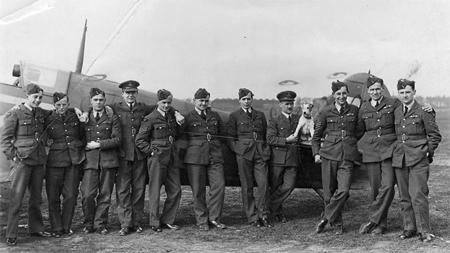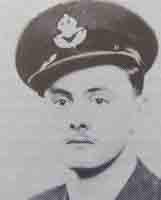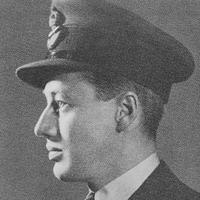Author Guest Post: Norman Ridley
The Decimation of 266 Squadron
The Battle of Britain officially lasted for three and a half months from the 10th of July to the 31st of October 1940, but for one squadron of Fighter Command it essentially lasted for little more than a week. Moved down from the relatively quiet Wittering Sector in the Midlands to the maelstrom of Tangmere on the south coast on the 9th of August, the men of 266 Squadron suddenly found themselves battling for survival at the very heart of the conflict. Pressed into service to face the Luftwaffe’s monumental ‘Eagle Day’ attack, losses by the 18th, nine days later, had amounted to eleven Spitfires destroyed, six badly damaged, seven pilots dead and two more wounded. By the 21st what was left of 266 was back in Wittering struggling to cope with the losses and remained there for the duration. It was not the end of their tragedy, however, Pilot Officer Williams, a New Zealander who, on the 12th of August had only just managed to scramble out of his burning aircraft before his fuel tank exploded, was later to die on the 21st of October when his aircraft inexplicably stalled on take-off and crashed.

The first two days at Tangmere were deceptively quiet. The cloud and rain had forced Reichsmarschall Göring to postpone his much vaunted ‘Adlerangriff’ (Eagle Attack) but the weather cleared on the 11th and a major raid developed over Weymouth. Hurricanes of 601 Squadron were put up from Tangmere but 266 were not called out. They were apparently ready for action by the 12th, however, when, just before noon, an alert scrambled them and put Squadron Leader R. L. Wilkinson in the air with eleven of his pilots to lead a dozen Spitfires on patrol over the Isle of Wight in anticipation of a Luftwaffe raid. As they were climbing to their allocated height of 20,000 feet they were suddenly diverted to Portsmouth where a group of Junkers Ju88s with Messerschmidt Bf110 support were bombing the harbour. The whole sky was full of aircraft and 266 combat reports of their first encounters with massed Luftwaffe formations estimated as many as five hundred which was clearly an exaggeration, but the official figures still put the total in excess of one hundred and fifty Luftwaffe aircraft, outnumbering the whole defence put up by Fighter Command by more than two to one.
The Luftwaffe tactic was to send in the bombers low and hold back the fighter escorts until RAF fighters appeared at which point, with the advantage of height and position, they would swoop down from above and pick them off. Fortunately for 266, it was the twin-engine Bf110s escorting the bombers in their area rather than the much more manoeuvrable and swifter Bf109s. Seasoned RAF pilots had learned how to exploit the weaknesses of the Bf110 but, in their first engagement since the 2nd of June over Dunkirk, the pilots of 266 had to learn very quickly how to cope.
The bombers had unloaded their ordnance; were dropping to wave-height with open throttle gaining speed and heading for home as the Spitfires caught up with them striking eighteen enemy aircraft claiming 2 downed, 4 probably destroyed and 12 damaged. Such a ferocious encounter could not be without loss for the squadron, however. The aircraft of Pilot Officer Dennis Garth Ashton from Nottingham was seen to go out of control with smoke pouring from its engine and plunge straight into the sea. He was 20 years old. His body was later recovered by a Navy minesweeper and identified by his car key fob. The 12th was also the day on which another 20-year-old, Pilot Officer Wycliff Stuart Williams, narrowly survived his crash-landing.

Pilot Officer Dennis Garth Ashton Age 20
Although three major Luftwaffe raids swept across Portsmouth and Weymouth on the 13th, 266 Squadron was not called up. Neither did it engage on the 14th when low cloud kept the Luftwaffe bombers on the ground but on the 15th it had been moved up to Eastchurch to bolster the defences against massed Luftwaffe attacks on Kent aerodromes. Early in the day 266 Spitfires had patrolled the Thames Estuary without making contact but at around 16.00 hrs. nine of them refuelled and set off to chase a lone Luftwaffe Arado 196 spotter plane back across the Channel. Sergeant Eade pursued it as far as the French coast and succeeded in destroying it but, turning for home and unable to fire three of his guns which had jammed, he was shot down by four Bf109s arriving just too late to save the Arado. An hour later, 266 Spitfires were again put up from Manston to join more than fifty other fighters engaging over one hundred enemy aircraft. 266 were first in and succeeded in breaking up part of the enemy formations which allowed them to choose targets at will. The battle sprawled over the whole Kent countryside from London to Dover. The squadron claimed two destroyed and two damaged but 25-yer-old Pilot Officer Cale, from Perth, Australia, took return fire and his Spitfire was burning. As he baled out the flames ignited his parachute and he died hitting the waters of the Thames near Teston. Although Flight Lieutenant Armitage had evaded enemy fire while emptying his guns into a Ju88, a ground anti-aircraft gun inadvertently put a shell through his fuselage making his journey home somewhat precarious, but he managed to land safely. The toll was mounting but the next day was to prove decisive.
266 had moved, yet again, this time to Hornchurch, and ten of their aircraft were in the air just before noon on the 16th patrolling above Manston aerodrome when 100+ Luftwaffe aircraft approached the Kent coast between Dungeness and Margate. The ground controllers had put them at 20,000 feet which was too high to spot the Dorniers flying 10,000 feet below them and heading for Tilbury Docks but even at that height they were still 2,000 feet below the Bf109 escorts which wasted no time in bouncing them from out of the noonday sun. Within the space of twenty minutes four of their Spitfires had gone down with three pilots dead, including Squadron Leader Wilkinson, one parachuting down with bad burns and one limping back to Manston injured. Wilkinson’s aircraft had collided with the Messerschmidt of Unteroffizier Buder who, unlike his adversary, baled out safely and was made POW. Apart from Buder’s there were no other enemy aircraft confirmed destroyed by 266 in the encounter. The squadron now had only thirteen combat-ready pilots as opposed to twenty-one only four days earlier.

Squadron Leader Rodney Levett Wilkinson
The next day was eerily calm as the Luftwaffe commanders assessed the results of their ‘Eagle Day’ attack but on the 18th another massive raid swept in over the south-east counties just after noon intent on bombing Manston, Kenley and Biggin Hill as part of Göring’s master plan to destroy all Fighter Command aerodromes south of London. 266 was moving up to Manston, its forward operating base that day, and diverted ten of its aircraft to intercept the raiders around Dover. They engaged the enemy briefly and claimed two aircraft hit but were soon forced down to re-fuel. They landed at Manston aerodrome just as the Luftwaffe struck. Pilots and crew ran for cover leaving the aircraft like sitting ducks on the field. Two went up in flames and five others were raked by machine gun fire from Bf109s. The hanger housing much of their equipment and support facilities was bombed and destroyed by Heinkel He111s.
For 266 Squadron that was the coup de grace. Two more pilots suffered injury and more than half their aircraft were lost. On top of that, they had lost their 30-year-old commander, Squadron Leader Wilkinson, a very experienced flier who had first entered Cranwell as a cadet in 1929 and who had died leading his men over that corner of England where he had been born and brought up.
Three days later on the 21st, what was left of 266 Squadron was withdrawn back to Wittering where they remained for the duration of the Battle. Their aircraft stock was replenished, and new pilots were quickly brought in to make up the full complement of 21. Squadron Leader Spencer, another very experienced officer, who had been attached to the squadron since his return from France and Dunkirk in June took command and began the job of returning the squadron to combat readiness but they were not called up to the front line during the battle any more. Their battle had been short sharp and shocking. On the 31st of October, of the twenty-one pilots with the squadron on the 10th of July, only six remained, five of whom survived the war.

Order your copy here.

